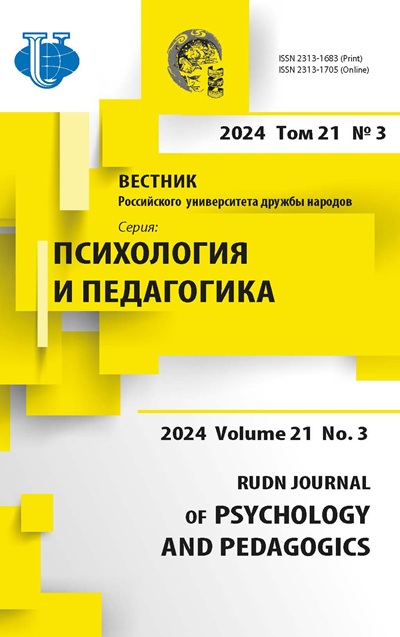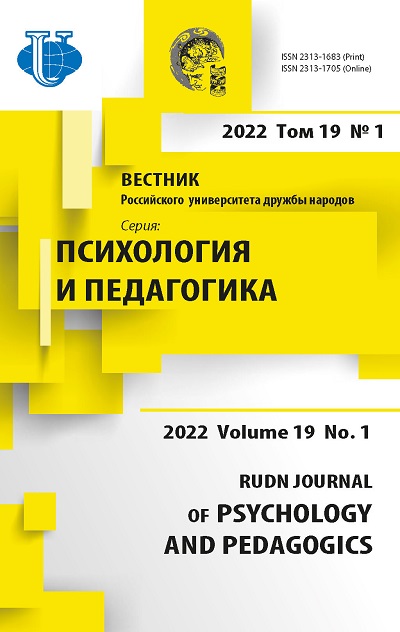The Ratio Commitment to Social Activity on the Internet and Physical Space among Young People
- Authors: Shamionov R.M.1, Suzdaltsev N.V.1
-
Affiliations:
- Saratov State University
- Issue: Vol 19, No 1 (2022)
- Pages: 21-38
- Section: PERSONALITY IN MODERN SOCIETY: ACTIVITY, IDENTITY, SAFETY
- URL: https://journals.rudn.ru/psychology-pedagogics/article/view/30738
- DOI: https://doi.org/10.22363/2313-1683-2022-19-1-21-38
Cite item
Full Text
Abstract
Due to large-scale shifts in the development of digital technologies, with the expansion of opportunities and the spread of the Internet environment, activity is increasingly being moved from the physical environment to the Internet environment. In this regard, one of the most important problems is to identify the correlation of activity in the two environments and its reflection in the social identity of young people. The purpose of this study is to analyze the ratio of personal commitment to social activity in the Internet and physical space, taking into account its forms and the depth of ethnic, religious and civic identity. The study involved 199 people aged 17-24 years (M = 20.02; SD = 2.7). Commitment to various forms of social activity in the physical and Internet environment was assessed using scales developed and modified by the authors. Identification with the institution of religion was revealed with the help of specially designed questions about belonging to a confession and the degree of religiosity. Civic identity was determined according to the scale developed by A.N. Tatarko. The certainty of ethnic identity was estimated using the scales by A.N. Tatarko and N.M. Lebedeva. Descriptive statistics methods, correlation and regression analyzes were used for data processing. It was found that commitment to civil, political or friendly activities does not depend on their involvement in a real or virtual environment. Leisure activities are mostly represented in the virtual environment. The certainty and positivity of ethnic identity are associated with pro-social and more acceptable forms of activity for young people, but its uncertainty is associated with protest forms of activity in both environments; civic identity is associated with the most preferred leisure activity in both environments, with volunteer activity and reduced protest activity in the real environment, political activity on the Internet and preference for activity in the Internet space; commitment to religion is associated with corresponding activity and conflicts with the protest, environmental and network ones, which mainly characterize leisure time. Activity in the physical environment is a stronger predictor of civic, ethnic and religious identity than in the Internet environment.
About the authors
Rail M. Shamionov
Saratov State University
Email: shamionov@mail.ru
ORCID iD: 0000-0001-8358-597X
Doctor of Sciences (Psychology), Professor, is Head of the Department of Social Psychology of Education and Development
83 Astrakhanskaya St, Saratov, 410012, Russian FederationNikita V. Suzdaltsev
Saratov State University
Author for correspondence.
Email: nvgulkosaratov@gmail.com
ORCID iD: 0000-0003-3419-2998
Postgraduate Student, Department of Social Psychology of Education and Development
83 Astrakhanskaya St, Saratov, 410012, Russian FederationReferences
- Arendachuk, I.V. (2018). Value-based meaningful characteristics of social activity of youth, depending on the forms of its manifestation. Izvestiya of Saratov University. New Series. Series: Philosophy. Psychology. Pedagogy, 18(4), 425–432. (In Russ.) https://doi.org/10.18500/1819-7671-2018-18-4-425-432
- Bocharova, E.E. (2019). Typical spheres of social activity manifestation in modern youth. RUDN Journal of Psychology and Pedagogics, 16(3), 359–376. (In Russ.) https://doi.org/10.22363/2313-1683-2019-16-3-359-376
- Chan, M., & Guo, J. (2013). The role of political efficacy on the relationship between Facebook use and participatory behaviors: A comparative study of young American and Chinese adults. Cyberpsychology, Behavior, and Social Networking, 16(6), 460–463. https://doi.org/10.1089/cyber.2012.0468
- Dontsov, A.I., Stefanenko, T.G., & Outalieva, Zh.T. (1997). Language as a factor of ethnic identity. Voprosy Psychologii, (4), 75–86. (In Russ.)
- Fedorova, M.V. (2020). Religious identity in the modern digital world. Sotsiodinamika, (6), 66–79. (In Russ.) https://doi.org/10.25136/2409-7144.2020.6.33085
- Gigauri, D.I. (2021). 2021 State Duma elections: Blogs, social networks, and party identity in the virtual space. Sotsiodinamika, (11), 1–21. (In Russ.) https://doi.org/10.25136/2409-7144.2021.11.36962
- Grigorieva, M.V. (2020). The specifics of social activity forms of an individual and groups depending on socio-demographic characteristics and level of education. Obshchestvo: Sotsiologiya, Psikhologiya, Pedagogika, (8), 48–52. (In Russ.) https://doi.org/10.24158/spp.2020.8.8
- Guseinov, A.Sh., Ryabikina, Z.I., Fomenko, G.Yu., & Shipovskaya, V.V. (2017). The phenomenon of protest activity: A subjective-existential interpretation. Rossiiskii Psikhologicheskii Zhurnal, 14(4), 78–96. (In Russ.) https://doi.org/10.21702/rpj.2017.4.4
- Jost, J.T., Barberá, P., Bonneau, R., Langer, M., Metzger, M., Nagler, J., Sterling, J., & Tucker, J.A. (2018). How social media facilitates political protest: Information, motivation, and social networks. Political Psychology, 39(S1), 85–118. https://doi.org/10.1111/pops.12478
- Krasilshchikov, V.V., & Osetrov, M.A. (2017). The analysis of students’ activity in social network. Vysshee Obrazovanie v Rossii, (2), 52–62. (In Russ.)
- Kudinov, S.S. (2014). Social activity as basis of self-realization of the personality. Acmeology, (S1–2), 124–125. (In Russ.)
- Melnikova, N.M., Kuznetsova, S.A., & Charina, E.V. (2021). The virtual world as a way to preserve and form ethnic identity in the context of migration. Vestnik of North-Eastern Federal University. Pedagogics. Psychology. Philosophy Series, (4), 118–125. (In Russ.)
- Ozerina, A.A., & Timofeeva, T.S. (2019). Possibilities for analyzing representations of urban identity in social networks. Penza Psychological Newsletter, (2), 58–67. (In Russ.) https://doi.org/10.17689/psy-2019.2.6
- Pan, S. (2019). Identity, civic engagement, and learning about citizenship: University students’ experiences in Hong Kong. Compare: A Journal of Comparative and International Education, 51(7), 945–964. https://doi.org/10.1080/03057925.2019.1687286
- Popov, L.M., & Ustin, P.N. (2021). Cognitive-behavioral concept and possibilities of its implementation in students’ life activity. Psikhologicheskii Zhurnal, 42(1), 26–35. (In Russ.) https://doi.org/10.31857/S020595920013324-2
- Regush, L.A., Orlova, A.V., Alekseeva, E.V., Veretina, O.R., Pezhemskaya, Y.S., & Laktionova, E.B. (2021). Phenomenon of the internet immersion: Definition and measurement. Sibirskiy Psikhologicheskiy Zhurnal, (81), 107–125. (In Russ.) https://doi.org/10.17223/17267081/81/5
- Ryabikina, Z.I., & Bogomolova, E.I. (2015). Interrelation personality characteristics of users of social networks in the internet with the features of their network activity. Polythematic Online Scientific Journal of Kuban State Agrarian University, (109), 1041–1057. (In Russ.)
- Sapozhnikova, R.B. (2005). Analiz ponyatiya “identichnost’:” Teoreticheskie i metodologicheskie osnovaniya. Tomsk State Pedagogical University Bulletin, (1), 13–17. (In Russ.)
- Savina, I.S. (2021). Life prospects of the individual in the context of social activity in adolescence. Vestnik Nauki i Obrazovaniya, (7–1), 95–100. (In Russ.)
- Savrasova-V’un, T. (2017). Social networks and their role in development of civic activity of the Ukrainian youth. Communication Today, 8(1), 104–113.
- Seigfried-Spellar, K.C., & Lankford, C.M. (2018). Personality and online environment factors differ for posters, trolls, lurkers, and confessors on Yik Yak. Personality and Individual Differences, 124, 54–56. https://doi.org/10.1016/j.paid.2017.11.047
- Shamionov, R.M. (2018). Social activity of personality and groups: definition, structure and mechanisms. RUDN Journal of Psychology and Pedagogics, 15(4), 379–394. (In Russ.) https://doi.org/10.22363/2313-1683-2018-15-4-379-394
- Shamionov, R.M. (2019). Social activity of youth: A systematic diachronic approach. Rossiiskii Psikhologicheskii Zhurnal, 16(1), 166–188. (In Russ.) https://doi.org/10.21702/rpj.2019.1.8
- Shamionov, R.M. Psychological characteristics of a personality’s social activity. The World of Psychology, (3), 145–154. (In Russ.)
- Shamionov, R.M., Grigorieva, M.V., Arendachuk, I.V., Bocharova, E.E., Usova, N.V., Klenova, M.A., Sharov, A.A., & Zagranichnyi, A.I. (2020). Psikhologiya sotsial'noi aktivnosti molodezhi. Moscow: Pero Publ. (In Russ.)
- Sharov, A.A. (2019a). Deviant behavior of young people: Some aspects and mechanism of transfer from real to virtual settings. The Bulletin of Irkutsk State University. Series: Psychology, 28, 103–109. (In Russ.) https://doi.org/10.26516/2304-1226.2019.28.103
- Sharov, A.A. (2019b). Features of deviant activity in real and virtual environments among representatives of youth subcultures. Uchenye Zapiski Universiteta imeni P.F. Lesgafta, (3), 450–453. (In Russ.)
- Sherman, L.E., Greenfield, P.M., Hernandez, L.M., & Dapretto, M. (2018). Peer influence via Instagram: Effects on brain and behavior in adolescence and young adulthood. Child Development, 89(1), 37–47. https://doi.org/10.1111/cdev.12838
- Soboleva, M.O. (2021). Features of the construction of research on virtual identity of users of social networks. RSUH/RGGU Bulletin. Series: Psychology. Pedagogics. Education, (4), 14–23. (In Russ.) https://doi.org/10.28995/2073-6398-2021-4-14-23
- Sokhadze, K.G. (2017). Social activity of the Russian youth: The scope and restraining factors. RUDN Journal of Sociology, 17(3), 348–363. (In Russ.) https://doi.org/10.22363/2313-2272-2017-17-3-348-363
- Tatarko, A.N., & Lebedeva, N.M. (2011). Metody etnicheskoi i krosskul'turnoi psikhologii. Moscow: HSE Publishing House. (In Russ.)
- Zagranichny, A.I. (2019). The aspects of the social involvement of the youth in virtual and real environments. Obshchestvo: Sotsiologiya, Psikhologiya, Pedagogika, (4), 95–98. (In Russ.) https://doi.org/10.24158/spp.2019.4.16
















